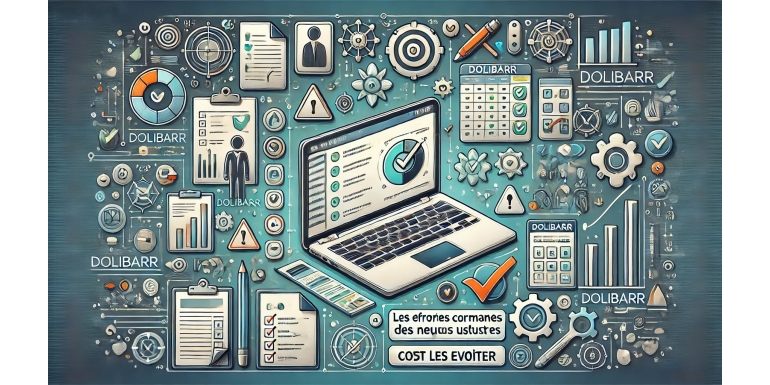
Introduction
Dolibarr is one of the most popular open-source ERP & CRM solutions for businesses looking to optimize their commercial, accounting, and administrative management. Its intuitive interface and modularity make it an ideal solution for small businesses, SMEs, and freelancers. However, like any software, effective use requires a good understanding of its features and best practices.
New users often make some mistakes that can slow down their onboarding process or create problems in managing their business. This article highlights the most common mistakes and provides advice on how to avoid them.
1. Poor Initial Configuration of Dolibarr
One of the first obstacles new users face is improper software configuration during installation. A poorly set up installation can cause display issues, access restrictions, or module interconnection problems.
How to Avoid This Mistake?
-
Read the Documentation: Before installing Dolibarr, take the time to read the official documentation to understand the software requirements.
-
Set Up Basic Parameters: Properly define the currency, taxes, date, and time formats.
-
Enable Only Necessary Modules: Avoid overloading your interface with unnecessary modules that can slow down the software.
2. Not Regularly Backing Up Data
Many users forget to set up a regular backup system, which can be problematic in case of server failure or data loss.
How to Avoid This Mistake?
-
Set Up Automatic Backups: Use tools like mysqldump to back up the database or enable the built-in backup feature in Dolibarr.
-
Store Backups on an External Server: To prevent data loss in case of hardware failure, store your backups on a secure cloud or a remote server.
3. Poor Management of User Access Rights
Dolibarr allows the creation of multiple users with different access levels. Some administrators assign too many permissions to unqualified users, leading to errors or accidental deletion of sensitive data.
How to Avoid This Mistake?
-
Create Appropriate User Profiles: Ensure that each employee only has access to the necessary modules.
-
Use User Groups: Instead of assigning permissions individually, create groups (accounting, sales, administration) with specific rights.
-
Regularly Audit Access Logs: Check activity logs and adjust permissions if needed.
4. Poor Stock and Product Management
Dolibarr offers a stock management module, but some users fail to use it correctly. This can lead to inconsistencies in stock levels and errors in order management.
How to Avoid This Mistake?
-
Enable Stock Tracking: Activate stock management and configure reorder levels.
-
Regularly Update Quantities: Ensure that stock entries and exits are recorded correctly after each transaction.
-
Use Stock Alerts: Set up alerts to prevent stock shortages or overstocking.
5. Incorrect Use of Integrated Accounting
Dolibarr includes a powerful accounting module, but some users do not use it correctly or ignore essential features.
How to Avoid This Mistake?
-
Properly Configure the Accounting Plan: Ensure that your accounting plan is well-defined and complies with applicable regulations.
-
Record All Transactions: Do not leave invoices or payments unrecorded in the system.
-
Use Bank Reconciliation: Match bank movements with accounting entries to avoid treasury management errors.
6. Not Utilizing CRM Features
Dolibarr's CRM module is often underutilized by new users, despite its potential to significantly improve customer relationship management.
How to Avoid This Mistake?
-
Create Detailed Customer Records: Record key information about each customer (purchase history, contact details, pricing conditions).
-
Track Sales Opportunities: Use the sales pipeline to follow up on leads and avoid missing sales.
-
Schedule Automated Follow-ups: Set up reminders to follow up with customers and leads at strategic times.
7. Not Using Reports and Analytics
Dolibarr has powerful reporting tools, but many users do not review them regularly, limiting their ability to make strategic decisions.
How to Avoid This Mistake?
-
Regularly Check Dashboards: Analyze key indicators to assess your company's financial and commercial health.
-
Customize Reports: Adapt reports to your company's needs to better understand performance.
-
Export Data: Use Excel or PDF exports to share analyses with your teams or financial partners.
Conclusion
Dolibarr is a powerful and flexible tool that can transform your business management, provided you avoid common mistakes new users make. By correctly configuring the software, efficiently using its modules, and leveraging advanced features, you can maximize its potential and optimize your daily management.
By applying these best practices, you will save time, reduce errors, and improve your company's overall performance with Dolibarr.
